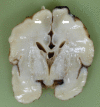Anaphylaxis in pregnancy: a rare cause of neonatal mortality
- PMID: 23314874
- PMCID: PMC3603634
- DOI: 10.1136/bcr-2012-007055
Anaphylaxis in pregnancy: a rare cause of neonatal mortality
Abstract
Anaphylaxis is a rare condition in pregnancy. Drugs are the aetiological agents most often implicated. Maternal anaphylaxis can lead to significant fetal morbidity and even mortality if uterine perfusion and maternal oxygenation are compromised. Significant risk of neonatal neurological damage or death can occur even when the maternal clinical outcome is favourable. The authors present the case of a newborn, born at gestational age of 29 weeks, who died at 11 days of life with hypoxic-ischaemic cerebral injuries as a consequence of maternal anaphylaxis following the administration of amoxicillin in the community setting.
Figures







Similar articles
-
[Anaphylaxis in terminal pregnancy: two case studies and review of the literature].Ann Fr Anesth Reanim. 2009 Sep;28(9):790-4. doi: 10.1016/j.annfar.2009.06.023. Epub 2009 Jul 30. Ann Fr Anesth Reanim. 2009. PMID: 19646842 Review. French.
-
Anaphylaxis in late pregnancy: plasma concentrations of histamine, tryptase and IgE in the neonate.Int J Obstet Anesth. 2018 Nov;36:138-139. doi: 10.1016/j.ijoa.2018.02.007. Epub 2018 Mar 2. Int J Obstet Anesth. 2018. PMID: 29653877 No abstract available.
-
Maternal anaphylactic shock in pregnancy: A case report.Medicine (Baltimore). 2018 Sep;97(37):e12351. doi: 10.1097/MD.0000000000012351. Medicine (Baltimore). 2018. PMID: 30212990 Free PMC article.
-
Maternal anaphylaxis and fetal brain damage after intrapartum chemoprophylaxis.J Perinat Med. 2004;32(4):375-7. doi: 10.1515/JPM.2004.070. J Perinat Med. 2004. PMID: 15346827
-
Brain death in pregnancy: a systematic review focusing on perinatal outcomes.Am J Obstet Gynecol. 2021 May;224(5):445-469. doi: 10.1016/j.ajog.2021.01.033. Epub 2021 Feb 16. Am J Obstet Gynecol. 2021. PMID: 33600780
Cited by
-
The incidence, characteristics, management and outcomes of anaphylaxis in pregnancy: a population-based descriptive study.BJOG. 2018 Jul;125(8):965-971. doi: 10.1111/1471-0528.15041. Epub 2018 Jan 3. BJOG. 2018. PMID: 29193647 Free PMC article.
-
Evaluation and Management of Women and Newborns With a Maternal Diagnosis of Chorioamnionitis: Summary of a Workshop.Obstet Gynecol. 2016 Mar;127(3):426-436. doi: 10.1097/AOG.0000000000001246. Obstet Gynecol. 2016. PMID: 26855098 Free PMC article.
-
Antibiotics, Inflammation, and Preterm Labor: A Missed Conclusion.J Inflamm Res. 2020 May 25;13:245-254. doi: 10.2147/JIR.S248382. eCollection 2020. J Inflamm Res. 2020. PMID: 32547156 Free PMC article. Review.
-
Clinical chorioamnionitis at term VIII: a rapid MMP-8 test for the identification of intra-amniotic inflammation.J Perinat Med. 2017 Jul 26;45(5):539-550. doi: 10.1515/jpm-2016-0344. J Perinat Med. 2017. PMID: 28672752 Free PMC article.
-
Two lives at stake: Obstetric anaphylactic shock resulting in acute respiratory distress syndrome - A case report.SAGE Open Med Case Rep. 2022 Mar 16;10:2050313X221084843. doi: 10.1177/2050313X221084843. eCollection 2022. SAGE Open Med Case Rep. 2022. PMID: 35320983 Free PMC article.
References
-
- Mulla ZD, Ebrahim MS, Gonzalez JL. Anaphylaxis in the obstetric patient: analysis of a statewide hospital discharge database. Ann Allergy Asthma Immunol 2010;104:55–9 - PubMed
-
- Chaudhuri K, Gonzales J, Jesurun CA, et al. Anaphylactic shock in pregnancy: a case study and review of the literature. Int J Obstet Anesth 2008;17:350–7 - PubMed
-
- Sengupta A, Kohli JK. Antibiotic prophylaxis in cesarean section causing anaphylaxis and intrauterine fetal death. J Obstet Gynaecol Res 2008;34:252–4 - PubMed
-
- Khan R, Anastasakis E, Kadir RA. Anaphylactic reaction to ceftriaxone in labour. An emerging complication. J Obstet Gynaecol 2008;28:751–3 - PubMed
-
- Gei AF, Pacheco LD, Vanhook JW, et al. The use of a continuous infusion of epinephrine for anaphylactic shock during labor. Obstet Gynecol 2003;102:1332–5 - PubMed
Publication types
MeSH terms
Substances
LinkOut - more resources
Full Text Sources
Other Literature Sources
Medical
